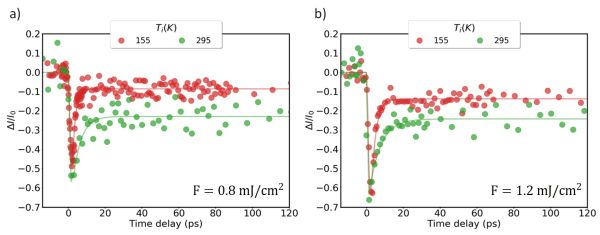Recent time-resolved diffraction techniques allow the dynamic study of matter with unprecedented spatio-temporal resolution [1], typically on time scales as short as a few hundred femtoseconds. Such study has become possible in the laboratory thanks to the development of ultra-short pulse lasers that allow the generation of packets of X-rays or electrons with wavelengths and durations adapted to probe atomic motions.
Isabel Gonzalez Vallejo received the 2020 thesis award (awarded in 2021) from the French Crystallography Association (AFC) in collaboration with Laboratoire de Physique Appliqué (LOA) and the LPS. During her thesis work, isabel used ultrafast electron diffraction to study the structural dynamics of various phase transitions. The technique is based on the “pump-probe” scheme, which consists in exciting the material with an intense ultra-short laser pulse (the pump) that triggers a series of non-equilibrium processes in the electronic and crystalline structures. The dynamic evolution of these processes is then probed by a second electron pulse (the probe) by delaying the pump probe. The obtained diffraction images allow the realization of a stroboscopic film in the reciprocal space and reveal the dynamics of processes such as chemical reactions, coherent phonons or here structural phase transitions [1,2].

Isabel PhD work focused on the study of structural dynamics in phase transitions associated with the onset of a Charge Density Wave (CDW). After showing the influence of multiple scattering in time-resolved electron diffraction experiments [3], Isabel studied the non-equilibrium dynamics of the phase transition in GdTe3, a quasi-bidimensional compound exhibiting a unidirectional ODC state. The experiments were conducted for different laser fluences and at different temperatures below the transition. The intrinsic temperature of the crystal was estimated at each time delay from the effect of the thermal stirring of the crystal which affects the intensity of each Bragg peak via the Debye Waller. The system undergoes an ultrafast non-thermal phase transition. As shown in the figure below, the charge density wave disappears very quickly, in less than one picosecond after photo-excitation, then stabilizes in 6 ps corresponding to a quasi-equilibrium temperature different from the initial temperature. The correlation lengths of the ODC could be measured revealing the role of defects in the reordering. The relaxation times increase linearly with the fluence but also strongly depend on the initial temperature of the crystal. Moreover, a new ODC transient phase induced by the laser pulse, which is not present at thermodynamic equilibrium, has been recently observed in similar systems LaTe3 and CeTe3. We did not observe this photo-induced phase in our GdTe3 samples, an absence probably related to the proximity of the disordered phase. This study has just been published in Structural Dynamics [4].

References
[1] R. J. D. Miller, Science 343, 1108 (2014)
[2] G. Sciaini, Appl. Sci. 9, 1427 (2019)
[3] Isabel González Vallejo, Geoffrey Gallé, Brice Arnaud, Shelley A. Scott, Max G. Lagally, Davide Boschetto, Pierre-Eugene Coulon, Giancarlo Rizza, Florent Houdellier, David Le Bolloc’h, and Jerome Faure, Phys. Rev. B 97, 054302 (2018)
[4] Time-resolved structural dynamics of the out-of-equilibrium charge density wave phase transition in GdTe3,” I. González-Vallejo, V. L. R. Jacques, D. Boschetto, G. Rizza, A.Hadj-Azzem, J. Faure and D. Le Bolloc’h, Structural Dynamics (Vol.9, Issue 1, 2022) DOI: 10.1063/4.0000131
Contact
David Le bolloc’h